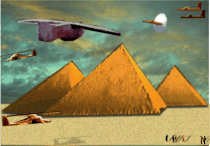Dinosaurs in Literature, Art & History--A Few Items of Interest... Page 22

Pre-Columbian Dinosaur?



Fragment.
Late Intermediate Period.
A.D. 1000–1476 Pre-Columbian
Cotton and wool slit tapestry
Height and Width: 7 1/16 x 7 11/16 in. (18 x 19.5 cm)
MFA, Boston.
We can't say for certain that this stylized animal represents the dinosaur type shown. It seems clear to us that it is intended to represent a type of dinosaur. What do you think?

Egyptian Dinosaur-like Creature
Click and drag photo to resize. 

Tapestry.
Egyptian (Coptic)
8th century
Linen
Height and Width: 6 11/16 x 8 1/16 in. (17 x 20.5 cm)
MFA, Boston. Denman Waldo Ross Collection
Ground: cream linen cloth; plain selvedge at right. Stained; small holes. Design: tapestry band in pale-yellow, red, blue, green, and brown silk and cream linen. Red band with pair of grotesque affronted elephants (one blue and one yellow); seperated by yellow triangular shaft. At right is fantastic green animal. Band is edged at top and bottom with narrow cream and red stripes. (The photo is black and white. Color added to match description.) A snake head is created in part by the trunks of each pair of animals in the piece.
Speculation: "PROBOSCIDEA (animals with a proboscis ), the scientific name of the group of mammals represented at the present day only by the two species of elephant.
Although here regarded as a sub-order of UNGULATA (q.v.), the group is sometimes accorded the rank of an order by itself.1 .... Discoveries made during the first few years of the 20th century in the Lower Tertiary deposits of the Fayum district of Egypt have, however, brought to light the existence of several kinds of primitive proboscideans which serve to link the group with other ungulates, and likewise apparently indicate affinity with the Sirenia."..LovetoKnow Encyclopedia

Early Recognition of Bi-pedalism in Dinosaurs?
Click and drag photo to resize. 

White cotton
Mexican
Cotton and brocade
Overall: 21 x 42 cm (8 1/4 x 16 9/16 in.)
MFA, Boston Denman Waldo Ross Collection
The design, which consists of double headed eagles and rampant animals, is of red, deep violet and yellow wool. Much worn.
"It is generally accepted that the first discovery of dinosaur remains in North America was made in 1854 by Ferdinand Vandiveer Hayden during his exploration of the upper Missouri River.
Near the confluence of the Judith and Missouri Rivers (shown above) Hayden's party recovered a small collection of isolated teeth which were later described by the Philadelphia paleontologist Joseph Leidy in 1856, in the Proceedings of the Academy of Natural Sciences of Philadelphia.
A short two years later, Leidy had the honor of describing the first reasonably complete dinosaur skeleton the world would know, Hadrosaurus foulkii. Named after its discoverer William Parker Foulke, this specimen was recovered during quarrying of a sand pit in Haddonfield, New Jersey.
The real significance of this specimen was in its limb proportions. For the first time scientists studying these animals could see that some dinosaurs were bipedal, walking on two legs instead of on all fours. Bipedalism was a revolutionary thought for a reptilian posture."
…..University of California Museum of Paleontology
Museum Photos on This Page, Copyright: MFA, Boston.

1, 2, 3, 4, 5, 6, 7, 8, 9, 10
11, 12, 13, 14, 15, 16
17 18, 19,
20,
21,
22,
23,
24,
25,
26,
27,
28,
29,
30,
31,
32,
33,
34,
35,
36,
37,
38,
39,
40,
41,
42,
43,
44,
45,
46,
47
Next>>>


 Home
Home 20th Century Dinosaurs
20th Century Dinosaurs Dinosaurs in Literature, Art & History
Dinosaurs in Literature, Art & History Eyewitness Accounts
Eyewitness Accounts There Were Giants In The Earth in Those Days
There Were Giants In The Earth in Those Days Mega Fauna
Mega Fauna Those Sophisticated "Cave Men"
Those Sophisticated "Cave Men" Search for Noah's Ark
Search for Noah's Ark DNA, The Ultimate Oopart
DNA, The Ultimate Oopart The Bone Yards
The Bone Yards Underwater Cities, Monuments?
Underwater Cities, Monuments? Ancient Atomic Knowledge?
Ancient Atomic Knowledge? Salvation. What Must You Do To Be Saved?
Salvation. What Must You Do To Be Saved? Search
Search Links
Links Guestbook
Guestbook



